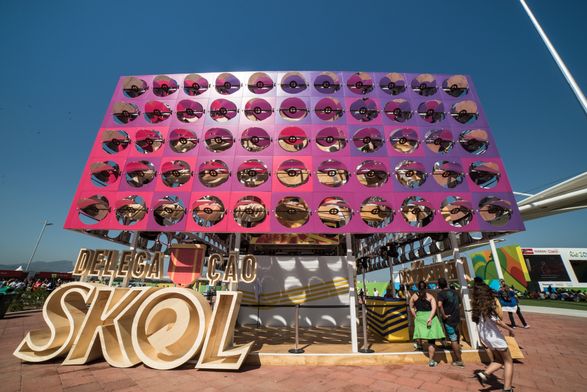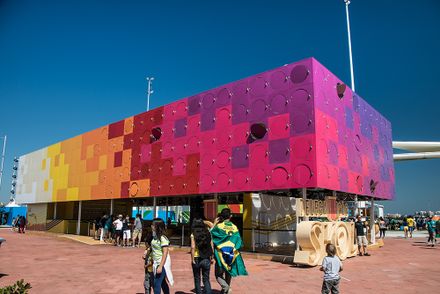
The Dancing Pavilion
ARCHITECTS
Estudio Guto Requena
SET DESIGN SUPPLIER
Un Cenografia
AUTHOR
Guto Requena
AGENCY
B!ferraz
CLIENT
Skol/ Ambev
ESTUDIO GUTO REQUENA TEAM
Ludovica Leone, Daniel Vianna, Bruno Baietto And Guilherme Giantini.
D3 TEAM
Pagu Senna, Diego Spinola, Carolina Anselmo, André Aureliano, Jonathan Querubina, Brenda Colautti, Natasha Weissenborn, Maria Clara Villas, Luciana Dal Ri, Vitor Reais, Victor Gama, Raphael Fagundes, Mariana Ventura, João Marcos De Souza, Edson Pavoni.
STATUS
Built
TECHNOLOGY AND MOTION DESIGN
D3
PHOTOGRAPHY
Fernanda Ligabue And Rafael Frazão
SIZE
3000 sqft - 5000 sqft
YEAR
2016
LOCATION
Rio de Janeiro, Brazil
CATEGORY
Cultural › Pavilion
Scattered sensors inside of the dance floor capture the beat of the music and the movement of people dancing, which activates the motors of the mirrors on the façade of the building.
The result is a kinetic architecture that hypnotizes people, and transforms the space into the most exciting dance club of the 2016 Olympics.
The pavilion was designed for a Brazilian beer brand to host music, parties, DJ’s and shows. Located in the Barra Olympic Park, the primary location for the stadiums in the Olympic Games Rio 2016, the building has an interactive architectural skin.
The outer face of the metallic skin is composed of various colors that suggest diversity. Inside is a gigantic surface of mirrors: What would it be like to dance inside of a disco ball?
Scattered sensors inside of the dance floor allow the skin to react to stimulations, such as the beat of the music or the excited commotion of people. This Interactive Architecture is made with around 500 round mirrors that spin, opening and closing, creating optic effects.
Under the sun, this kinetic pavilion creates graphics with light and shadow on the floor and its surroundings.
At night, light cannons dramatically cast an explosive light outside, calling attention as far as the entrance of the Olympic Park. As emotional architecture, it shivers like an excited body.
To create this experience of design and technology, we wanted to provoke the visitors of the largest sporting event on the planet.
We wanted to take them from a common place, to stimulate the athlete that exists in everyone, and bring them to a dream state of joy and escapism.
This project is an outcome of a research process that Estudio Guto Requena has been developing for the past 10 years, investigating hybrid architecture, weaving together our concrete and virtual worlds, using sensors and interactive technology to transform our perception of space and sharpen our sensoriality.














